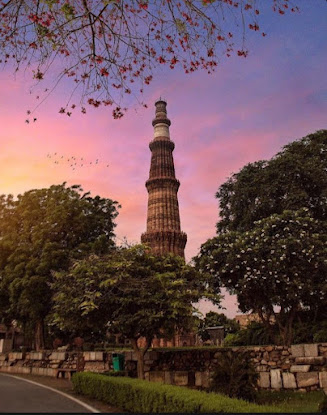Qutub Minar
What is written on Qutub Minar?
The Qutb Minar, sometimes called Qutub Minar and Qutab Minar, is a minaret and "victory tower" that is a component of the Qutb complex. Lal Kot, Delhi's oldest fortified city, was constructed by the Tomar Rajputs, and it is located at the location of the Qutb complex. It is located in South Delhi, India's Mehrauli neighbourhood, and is a UNESCO World Heritage Site. It was mostly constructed between 1199 and 1220 and is one of the most popular tourist attractions in the city. It can be compared to the 62-meter all-brick Minaret of Jam in Afghanistan, which was built in 1190, roughly a decade before the Delhi tower's likely beginning. Both have intricate geometric designs and inscriptions on their surfaces. The summit of each stage of the Qutub Minar includes a shaft that is fluted with "superb stalactite bracketing under the balconies." Generally speaking, India was late to adopt minarets, and those that do exist are frequently separate from the main mosque.
History Of Qutub Minar
Over the remains of the Lal Kot, the Dhillika citadel, was constructed the Qutb Minar. After the Quwwat-ul-Islam Mosque, which was began in 1192 by Qutub-ud-din Aibak, the first sultan of Delhi, Qutub Minar was built. The tower is commonly believed to bear Qutub-ud-din Aibak's name, who started it. Shamsuddin Iltutmish was a follower of Khwaja Qutbuddin Bakhtiar Kaki, a 13th-century sufi saint, therefore it's also conceivable that he inspired the name.Several historically noteworthy buildings from the Qutb complex surround the Minar. Qutub-ud-Din Aibak constructed the Quwwat-ul-Islam Mosque in 1198, to the northeast of the Minar. The Delhi Sultans constructed it, making it the oldest mosque still standing. It is made out of a rectangular courtyard surrounded by cloisters that were constructed using the carved columns and structural components from 27 Jain and Hindu temples that Qutub-ud-Din Aibak destroyed, as stated in his inscription on the building's main eastern entrance.
Later, Shams-ud-Din Itutmish (A.D. 1210–1235) and Ala-ud-Din Khalji extended the mosque and built a towering arched screen. According to an inscription on the iron pillar in the courtyard from the fourth century A.D., the pillar was erected as a Vishnudhvaja (standard of deity Vishnu) on the hill known as Vishnupada in honour of a powerful monarch by the name of Chandra. One of the earliest mosque complexes still standing in the Indian subcontinent.
A vestige of the tower's 19th-century repair, which included a disastrous attempt to add some additional storeys, is the neighbouring pillared cupola known as "Smith's Folly."Sikander Lodi restored Qutub Minar after it was destroyed by an earthquake in 1505. A large earthquake on September 1st, 1803, resulted in significant damage. In order to add a sixth storey, British Indian Army Major Robert Smith restored the tower in 1828 and added a pillared dome atop the fifth story. Under the direction of Viscount Hardinge, who was the Governor General of India at the time, the cupola was removed in 1848. To the east of Qutub Minar, it was reinstalled at ground level, where it is still today. Smith's Folly is the name for this.
It was added to the list of World Heritage Site by UNESCO in 1993.
In Popular Culture
The song "Dil Ka Bhanwar Kare Pukar" from Dev Anand's Bollywood movie Tere Ghar Ke Samne was intended to be filmed inside the Minar. The song was instead filmed inside a copy of the Qutb Minar because the cameras of the time were too large to fit within the tower's constricting corridor. The location served as the Pit Stop during the second leg of The Amazing Race Australia's second season.
The Delhi Metro Rail Corporation's trip cards and tokens have images of the minaret on them. A recent startup has made a 360o overview of Qutub Minar available in association with the Archaeological Survey of India.The Ministry of Tourism recently gave seven companies the 'Letters of Intent for fourteen monuments under its 'Adopt a Heritage Scheme.' These companies will be the future 'Monument Mitras.' Qutub Minar has been chosen to be part of that list.


Comments
Post a Comment